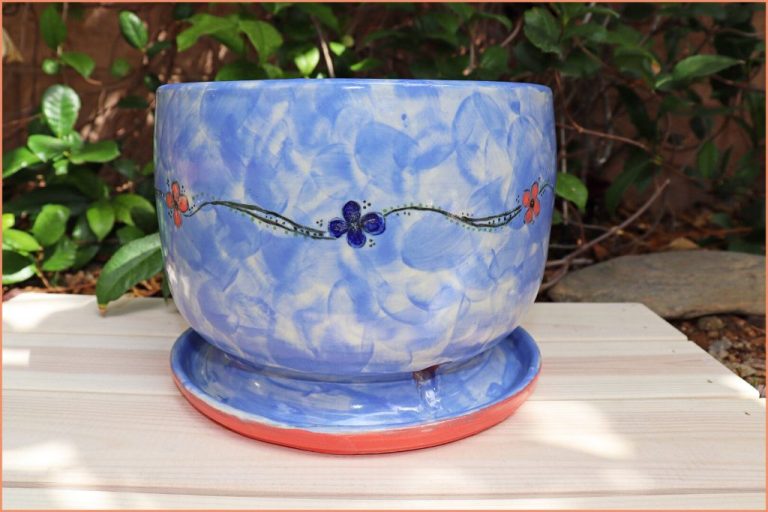Are Clay Pots Better Than Ceramic?
Defining Clay Pots
Clay pots, also known as terra cotta pots, are made from clay that is formed into pottery for uses like cooking, storing, and planting. Clay pots have an earthenware composition made from clays, quartz, and feldspar (Wikipedia). The steps for making clay pots include wedging and kneading the clay to remove air pockets, shaping the pot using techniques like throwing on a potter’s wheel or handbuilding methods, decorating or glazing, and firing the clay at high temperatures in a kiln (Wikihow).
There are many styles of clay pots including pinch pots, slab built pots, coiled pots, wheel thrown pots, pitchers and vases. They come in a variety of shapes, sizes and decorative styles. Clay pots have an earthy, organic aesthetic and add a rustic flair to indoor and outdoor decor. Their porous nature also provides effective drainage and aeration for plants.
Defining Ceramic
Ceramic is an inorganic, non-metallic solid that is often made by shaping then heating clay or other mineral mixtures. Ceramics are composed of metallic and non-metallic elements bonded together primarily through ionic and covalent bonds (Britannica). The most common elements used to make ceramics include oxygen, silicon, aluminum, carbon, and nitrogen.
Ceramics are produced by forming the raw minerals into a desired shape using methods like pressing, slip casting, tape casting, injection molding, and others. The shaped material, often called a “green body”, is then exposed to high heat by firing or sintering to permanently set its structure and properties (Wikipedia).
There are many types of ceramic materials, including earthenware, stoneware, porcelain, oxide ceramics like alumina, non-oxide ceramics like silicon carbide, and more. Ceramics are valued for properties like high hardness, heat resistance, chemical inertness, electrical insulation, and more.
Comparing Durability
Terracotta clay pots tend to be more durable and resistant to cracking or chipping compared to ceramic pots. The firing process used to create terracotta makes it denser and less porous than ceramic (source). Terracotta clay is baked at a lower temperature which causes it to retain more of its natural porosity and density. This makes terracotta less likely to crack or chip if dropped or knocked over.

Ceramic pots, on the other hand, are fired at higher temperatures which makes the clay denser and less porous. This process creates a more delicate material that is more prone to cracking and chipping from impacts (source). The glaze applied to ceramic pots also makes them more brittle. However, higher quality ceramic that is fired correctly can be quite durable.
Overall, terracotta tends to resist breakage better than ceramic. Its natural density gives terracotta an advantage in durability over the more delicate ceramic material.
Comparing Porosity
Porosity refers to the tiny pores within clay and ceramic materials. Both clay pots and ceramic pots contain pores, but clay tends to be more porous overall.
Terracotta clay has a high porosity, with countless small pores between the clay grains (1). This high porosity allows more air to reach the roots of plants in terracotta pots, which is beneficial for drainage and root growth.
Ceramics can vary greatly in porosity depending on factors like firing method and temperature. But ceramic materials tend to be less porous than natural clays. The pores in ceramics also tend to be smaller. This means less air circulation to the roots, which can be a drawback for some plants (2).
The high porosity of terracotta makes it generally better suited for plants that need excellent drainage and air flow to the roots. Plants in ceramic pots may require more careful watering to avoid overly wet soil.
1. https://digitalfire.com/glossary/clay+body+porosity
2. https://www.eyeofthedaygdc.com/2015/04/how-to-choose-a-terracotta-pot-by-its-porosity/
Comparing Thermal Properties
Clay pots and ceramic pots differ in their ability to retain heat. According to The Laws of Thermo-Culinary Dynamics, clay has a low thermal conductivity, meaning it conducts heat slowly. This allows clay pots to hold heat effectively once heated up. The porous nature of clay also helps retain moisture and heat during cooking.
Ceramics have a higher thermal conductivity than clay, so they don’t retain heat as well over time. However, ceramics heat up faster than clay initially. This means clay pots need more time to heat up, but will hold a more even temperature when cooking. The effects on cooking include:
- Clay pots allow slow cooking at relatively low temperatures.
- Ceramic pots can heat up quickly, but may drop in temperature during longer cooking.
- Clay’s moisture retention gives food a steamed texture.
- Ceramic’s poor moisture retention can lead to drier food.
Overall, clay offers superior heat retention for slow cooking methods, while ceramics excel at fast, high-heat cooking.
Comparing Price
There are some noticeable differences in price between clay pots and ceramic pots. Clay pots tend to be less expensive than ceramic pots. According to expertclay.com, the cost of the clay itself is very cheap, usually less than 50 cents per pot. However, factors like labor, firing costs, decorating, and glazing can increase the overall price. Still, handmade clay pots are generally cheaper than mass produced ceramic pots.
Ceramic pots are typically more expensive because they require higher firing temperatures and often have decorative glazes applied. The raw materials and production process for ceramic is more costly compared to basic clay. According to ceramicartsdaily.org, firing costs alone can be a few cents per ceramic pot. When factoring in overhead expenses, profit margins, and other variables, ceramic pots end up retailing for higher prices.
However, clay and ceramic pots can provide great value at their respective price points. Handmade clay pots add artisan appeal and uniqueness. Mass produced ceramic pots offer consistency, durability, and a wide variety of colors and decorations. Overall, ceramic pots tend to cost more than clay, but both offer quality and value depending on the customer’s needs and budget.
Comparing Aesthetics
When it comes to visual appeal, terracotta and ceramic pots offer different aesthetics. Terracotta pots have an earthy, rustic look with a textured orange-red finish. The natural clay material develops a patina over time, adding to the aged appearance. In contrast, ceramic planters come in a wide array of colors, glazes, and designs. From solid colors to intricate patterns, ceramic allows for more decorative options to match any style. Ceramic pots often have a more modern, sleek look compared to the traditional terracotta aesthetic.
For indoor use, many people prefer the clean and colorful look of ceramic planters. The extensive range of colors and finishes allows ceramic pots to blend in or stand out. Terracotta’s orange hue can contrast or clash with some home decors. Outdoor spaces suit the rugged, natural style of terracotta. The earthy terracotta look complements gardens, patios, and rustic settings. Those desiring a more polished, contemporary outdoor look may favor ceramic’s diversity of colors and finishes.
Environmental Impact
When evaluating the environmental impact of clay pots versus ceramic, we must consider factors like sustainability and carbon footprint.
Clay is a natural material that comes directly from the earth. Mining clay does disrupt the local environment, but clay itself is generally considered sustainable and renewable (https://thepotterywheel.com/pottery-clay-eco-friendly/). Fired clay is also biodegradable, breaking back down into natural components over time.
Ceramics start from natural materials like clay, but undergo more intensive processing and firing at high temperatures. This consumes more energy and leads to higher carbon emissions. However, ceramics can be recycled and reclaimed as raw materials, giving them sustainability if proper systems are in place (https://eluxemagazine.com/living/home/how-eco-friendly-is-ceramic/).
Overall, clay pots likely have a smaller carbon footprint and are considered more eco-friendly. But ceramics can also be sustainable depending on the materials and manufacturing processes used.
Use Cases
Clay pots and ceramic pots both have a variety of uses, but excel in different areas.
Cooking
Clay pots, especially unglazed terra cotta, are prized for cooking applications. According to https://plantcareforbeginners.com/articles/terracotta-vs-ceramic-pots, terra cotta’s porosity allows it to draw moisture from food, concentrating flavors. The natural clay material can also add beneficial minerals to food. Ceramic glazed pots are less ideal for cooking because the glaze prevents interaction between the clay and the food.
Planting
For planting, terracotta clay pots are often preferred because their porosity allows soil to breathe and prevents overwatering, according to https://lifehacker.com/the-difference-between-terracotta-ceramic-and-plastic-1847176578. The moisture-wicking properties of natural clay help plants thrive. Ceramic pots with glaze tend to retain moisture better, which can lead to overly damp soil.
Decoration
Glazed ceramic pots excel when used decoratively for their wide range of colors, patterns, and artistic finishes. According to https://platthillnursery.com/terracotta-vs-ceramic-pots-which-is-better-for-your-houseplants/, ceramics provide more decorative variety. Unglazed terra cotta has a rustic, traditional look but less range in colors and patterns.
Summary
Overall, both clay pots and ceramic pots have their advantages and disadvantages. Clay pots tend to be more porous, natural, and sustainable, making them ideal for cooking applications where moisture control is important. However, they are less durable and prone to cracking. Ceramic pots are tougher, more non-porous, and often more affordable, but they don’t provide the same natural cooking experience as clay.
When choosing between the two, consider factors like intended use, cooking needs, aesthetics, and budget. For more rustic cooking with enhanced steam circulation and heat retention, clay pots are the better choice. For more versatile day-to-day cooking at an affordable price, ceramic pots may be preferable. With proper care and maintenance, both clay and ceramic pots can provide many years of cooking enjoyment.


